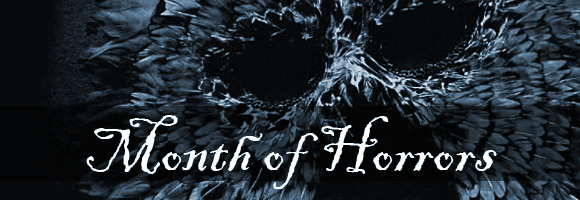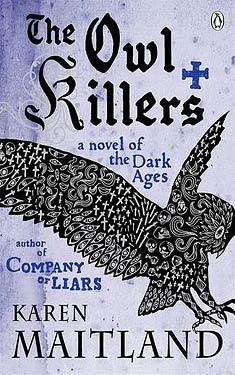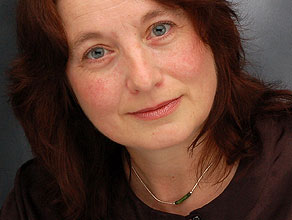The Owl Killers, by Karen Maitland

Today’s Month of Horrors review is from blogger and WWEnd member Valashain. This review originally appeared on his blog Val’s Random Comments, where he regularly reviews science fiction and fantasy books. The Owl Killers was a 2009 nominee for The Shirley Jackson Award.
The medieval period in Europe serves as an inspiration to many a fantasy novel. Apparently there is something very appealing to imagining oneself living in such an environment, so much so that our perception of the period has become more than a bit romanticized. In sharp contrast, history books tell us just how miserable and brutal life could be for a large part of the population. Historical fiction does not entirely escape the romanticizing of this period but quite a few novels attempt to paint a more realistic picture. Like Maitland’s previous book Company of Liars, The Owl Killers does not shy away form the harshness of life. Hunger, disease, natural disasters, oppressive taxation and unbridled religious madness, very little is spared the 14th century village the book depicts. It makes The Owl Killers in a very dark book. Fear is a main ingredient and the author makes sure the reader knows it.
 The Owl Killers is set in the year 1321 in the fictious village of Ulewic, located somewhere near Norwich. The church and a minor noble rule the village but below the surface old superstitions linger. Besides being caught between these two pillars of medieval life, the mysterious Owl Masters terrorize the village with their harsh brand of justice. Their presence appears to be a remnant from pre-Christian times, going back to pagan gods like Anu and Cernunnos. The cult has been slowly fading away since a last outburst a century ago. Their Aodh is not content to let this happen, he means to force the village to return to the old ways.
The Owl Killers is set in the year 1321 in the fictious village of Ulewic, located somewhere near Norwich. The church and a minor noble rule the village but below the surface old superstitions linger. Besides being caught between these two pillars of medieval life, the mysterious Owl Masters terrorize the village with their harsh brand of justice. Their presence appears to be a remnant from pre-Christian times, going back to pagan gods like Anu and Cernunnos. The cult has been slowly fading away since a last outburst a century ago. Their Aodh is not content to let this happen, he means to force the village to return to the old ways.
A recent development plays right into his hand. A group of Flemish Beguines, a recently established lay-religious order has acquired land near the village and built a beguinage. Their community appears to be thriving despite the difficult times. Hunger and disease seem to pass them by, raising suspicious of witchcraft. The actions of their stern, rather stubborn and sharp-tongued leader, a woman known as Servant Martha, doesn’t do much to increase their popularity in the village. When she takes in a villager cast out of the community because he developed leprosy, a head-on collision with the local community seems inevitable.
Part of the inspiration for this novel comes from the author’s interest in the Beguine movement, a lay-order that was mostly active in the Low Countries, Germany and France from the thirteenth century on. They never seem to have established themselves in England, although the author mentions in her historical note that there are hints that they did try. It reminded me of one of the major landmarks in the city of Amsterdam, het Begijnenhof. Although I was born in that city I’ve never actually been there. Considering the events that took place in the low countries during the reformation it is a miracle a community of Beguines survived into the 20th century. A more of less independent community of women, taking care of their own affairs in a time when women generally had little say over their lives. I can see the appeal of such a community.
Life in the Beguine community revolves around religion but the author also stresses the importance of the Catholic church in other parts of the novel. The chapters are named after the day they depict and these are referred to by the name day of a particular saint or martyr or a catholic feast. The reckoning of time and the habits, traditions and customs associated with that day are some of the many historical details of everyday life the author uses to draw the reader into the medieval setting. This focus on the life of ordinary people is also one of the major strength of Company of Liars. Little and not so little acts of faith and superstition drive the story.
 Although the church is a dominating force in the community the real fear that permeates the book is caused by the Owlman. A demon summoned by the Owl Masters that has not been seen for over a century. This supernatural force plays an important part in the eventual conclusion to the novel and is also the reason why I didn’t particularly like the ending. As one of the characters says in the final chapters, people create their own gods and demons. Given the minor presence of the demon early on in the book, and the horrific acts the people themselves are clearly capable of, the story doesn’t need this symbol of fear and superstition to take a physical form. The author makes it quite clear what the power of faith can do to people and it is more than enough to drive the story.
Although the church is a dominating force in the community the real fear that permeates the book is caused by the Owlman. A demon summoned by the Owl Masters that has not been seen for over a century. This supernatural force plays an important part in the eventual conclusion to the novel and is also the reason why I didn’t particularly like the ending. As one of the characters says in the final chapters, people create their own gods and demons. Given the minor presence of the demon early on in the book, and the horrific acts the people themselves are clearly capable of, the story doesn’t need this symbol of fear and superstition to take a physical form. The author makes it quite clear what the power of faith can do to people and it is more than enough to drive the story.
As with Maitland’s previous book I loved the historical component of the story, the well researched look into everyday life, the details on taxation by the church and landowners and the speculation about what might have happened to an attempt by the Beguine movement to gain a foothold in England in particular. The supernatural element is the book is used in a bit too literal a fashion I suppose. Do we really need a flesh and blood monster to create a sense of dread in a time that gave rise to some of the strangest cults and where the most absurd acts of faith (I really don’t have another word for starving yourself to death to get closer to god) were accepted as truly pious? The Owl Killers could have been a great examination to one of the darker sides of the human psyche but in the final chapters the balance tips to the unbelievable. It was a very interesting read but also something of a missed opportunity.



















 Full Details
Full Details


2 Comments
“Hunger, disease, natural disasters, oppressive taxation and unbridled… madness.”
With only one small change, that sentence can describe the 20th century exactly!
But seriously, this book does look worthwhile. I personally have a fascination with the Medieval period, but I also have a deep appreciation for modern technology (and plumbing). There’s a lot to love, and a lot to be concerned about, regarding the Middle Ages.
The reviews on Amazon suggest that the novel ends uncertain whether the demon is real or myth. Did you just read it differently, to say that the demon was obviously real?
Hmm, it has been two and a half years since I wrote this so the details are a bit fuzzy. As I remember it the author leaves you in doubt at to whether the demon is real of myth for most of the novel. At the end some stuff happens that is very hard to explain away though superstition of an unreliable narrator. I didn’t think the ending was ambiguous.
I’ve read two of Maitland’s other books as well and she doesn’t shy away from supernatural elements in those stories either.
Sorry, the comment form is closed at this time.